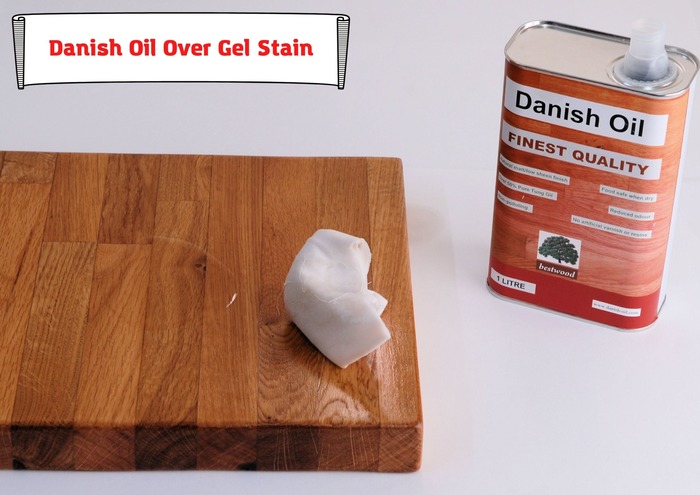
Staining, whether liquid or gel, is a great way to enhance the color of your woodwork. But there are many types of stains in the market, and they work with a limited choice of water or oil-based topcoat. So you may wonder if Danish oil can be applied over gel stain.
This article makes a case for Danish oil over gel stain. It discusses in detail why it makes sense to cover your gel-stained woodwork with Danish oil.
At the end, you will have a working understanding of Gel stain and Danish oil finish. You’ll also see convincing reasons Danish oil over gel stain makes so much sense and a few tips to get the best results while navigating some challenging situations.
Gel Stains and Danish Oil
Gel stains are oil-based varnishes that are rather thicker than traditional wood stains. It usually comes with a colorant and is not designed to soak into the wood.
Because it is not designed to be absorbed into the wood, it leaves an even color over all the surfaces of the wood. This is unlike liquid wood stain, which leaves a blotchy finish on the wood’s face grain and an unpleasant dark end grain.
It may soak in a little bit if it is new or unfinished wood, but the absorption will not be as impressive as liquid stains. Gel stains allow you to feel the underlying texture of the wood. It covers the color of the wood or a previous stain with its impressive hiding strength.
Woodworkers prefer them often because they are not as runny as liquid wood stains when you stain vertical surfaces. They are thicker, so they often leave an even tone as they do not run.
Does Danish Oil Over Gel Stain Make Sense?
All stains need a topcoat. So yes! Danish oil over gel stain makes sense. Do not be fooled by the urethane component of the gel stain. Woodworkers may be deceived because the urethane component of many brands gives the wood a luster, making them think there is no need for a topcoat.
Although the thick urethane carries a lot of color to the surface of the wood, it is better to think of the gel stain as a color that needs to be locked in and protected with a topcoat. So yes! Danish oil can do that well.
Also, Danish oil is an oil-based finish, and gel stains pair excellently with oil-based finishes like Danish oil. Check out these few reasons why it makes sense and what mistakes to avoid.
Why It Makes Sense

- Danish Oil Seals In The Gel Stain And Protects The Wood
Gel stains typically remain on the surface area of the wood rather than penetrate the wood as liquid stains do. This means that there is a risk of wearing off of colors for a variety of woods and hardwood especially. Parts of the stained wood subject to heavy use may wear off faster than expected.
Locking the gel stain with a topcoat of Danish oil will protect the gel stain and lock the gel stain in place by providing a durable cover. This will prevent quick and easy abrasions.
Also, gel stains do not protect the wood from natural elements. Danish oil has an impressive elasticity. This makes it great to follow your gel stain because woods expand and contract.
Once applied to the wood, Danish oil can expand and contract with the wood while giving adequate protection. It has excellent compatibility with woods which you will not find with other oil-based finishes in the market.
- Water Proof
Danish oil also offers protection from moisture and other liquid for the wood. It does this by locking out moisture and keeping the wood stable. It essentially protects the wood from drying out.
This is because its polymerization gives the surface a strong cover that prevents the penetration of water or any other liquid, for that matter.
The particles in Danish oil polymerize or become stronger after exposure to oxygen. This makes it a great waterproof choice to coat your gel-stained wood with.
Three coats of Danish oil are sufficient to seal and protect the wood from dirt and other external elements.
- Danish Oil Enhances The Luster Of The Wood
Oil-based stains like gel stains can be overcoated with any oil-based finish to give the wood an impressive luster. Danish oil is natural, clear, and durable.
Also, gel stains hardly enhance the fascinating look of the wood’s natural grain. This challenge reduces their value for impressively absorbent wood like oak, walnut, and mahogany. To deal with this, it would be advisable to give luster to the wood with Danish.
- Faster Drying Time
Unlike many other finishing oils in the market, Danish oil dries faster. It has an average drying time of about 6 hours under favorable weather conditions. So it is one of the best oil finishing to coat your gel-stained wood with.
Variation in humidity, temperature, and other weather conditions of your work area may affect the drying time. Drying time is usually shorter in warmer weather with low humidity. It may take longer in colder weather as the air is generally wetter.
Also, the different compositions of Danish oil from different manufacturers may have different drying times. But Danish oil dries faster than many other finishing oils in the market to go over your gel-stained wood.
- Toxicity
One excellent reason for using Danish oil over your gel-stained wood is its non-toxicity. Danish oil will make a great topcoat over the gel stain if the woodwork is household furniture or babies’ accessories. There are no toxic additives in Danish oil.
After you allow it to cure fully, it is completely safe to have around your kids.
Remember: you must let it cure completely before allowing your children to come in contact with the furniture.
- The Compatibility Saves Time
If you used liquid stains which are water-based, you would not have to wait for up to 48-72 hours before applying an oil-based finish like Danish oil.
But because Gel stain is an oil-based finish, it pairs excellently with oil-based top coats like Danish oil.
Tips To Get The Best

- Good Curing Time
Gel stains usually take some time to dry before you can coat the wood with an oil-based topcoat for protection. It will not help to use Gel stains if you want to have the topcoat applied quickly on it.
Also, Gel stains cannot be sprayed on. So if you intended to spray the Danish oil because you do not want brush or roller marks on the wood surface, then using a gel stain may not make sense.
One way to beat this is to use Japan drier to speed the drying time. Also, it would help to use a smooth rag instead of a brush or a roller if you are concerned about the stroke marks.
But ensure to let it dry out before disposing of it. If you fail to let it dry out before disposing of it, it will start a fire as it is combustible.
- Use For Special Project
Gel stains are usually thick. You may have issues with using them for projects that have lots of corners and small spaces as the gel stains can gather up in excess in these areas resulting in an uneven finish appearance.
To navigate this problem, it would help if you sanded down the darker parts before applying the Danish oil finishing.
Bottom Line
All stains should be protected with a topcoat. While some other oil finishes do not offer as much elasticity, compatibility, and lesser toxicity, Danish oil provides these and more. Besides, it is an oil-based coat which makes it an excellent pair for your gel stain.
What other oil finish could make more sense to lock in and protect the gel stain while giving it an outstanding luster? None but Danish oil.
- Can You Unmix Paint: Techniques, Consequences, Alternatives - February 23, 2024
- Does Primer Need to be Mixed? Effective Primer Application - February 22, 2024
- How to Make Old Paint Usable Again: Retrieving and Preserving Paint - February 21, 2024



